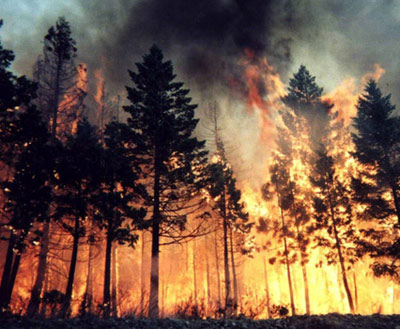Practical landscaping methods for reducing danger from wildfires in New Mexico

With all the smoke in the Albuquerque area, i thought re-posting this might be timely.
In the Albuquerque area we have many communities very close to national forests, the Rio Grande Bosque or the high desert. With the drought conditions we’ve faced for the past few years, these areas are prone to wildfires that can be a danger to homes and lives.
The area where homes, structures and other development encroach on forests, grasslands and other undeveloped natural areas is called the wildland-urban interface. Fires in the interface tend to be more damaging than urban structural fires, because these fires are more unpredictable and can spread quickly. Often it is hard to get fire equipment and the man power necessary to battle the fire quickly into position, because of terrain and other factors.
Homeowners who live in these areas often do not know of or disregard the dangers from wildfires. Homes and other structures are sometimes built and maintained in a manner that leaves them and their occupants vulnerable. As a result, fire is a real threat to homes, animals and humans.
The forest service and fire prevention organizations suggest creating a 30-foot zone of fire-resistant space around your home, to help prevent fires from starting near or spreading to your home. The 30-foot zone is a well-irrigated, fire-resistant area that circles the home and all its attachments, such as decks, fencing, etc. The main idea is to reduce the amount of fuel available to a fire.
Here are a few tips to get the landscaping around your property in ship shape for fire season:
- Plants should be carefully spaced, low-growing, and free of resins, oils and waxes that burn easily. Download a publication that lists fire resistant plants (some of these do well in New Mexico): Fire Resistant Plants
- Mow the lawn regularly.
- Sparks from lawnmowers and chainsaws and other power equipment can start wildfires. Make sure all your equipment is well maintained. Fuel equipment carefully, away from areas that are susceptible to fires.
- Remove tall, dry grasses. Tall, dry grasses provide a path for fire that can lead directly to a house.
- Prune trees up six to ten feet from the ground.
- Prune plants regularly.
- Remove cuttings and debris from property and dispose of properly
- Space conifer trees 30 feet between crowns. Fires can move from tree to tree.
- Trim back tree limbs that overhang the house. This is something our Tree Care division can do.
- Remove debris and litter from the roof and gutters.
- Create a ‘fire-free’ area within five feet of the home, using non-flammable landscaping materials and/or high-moisture-content annuals and perennials. Gravel is ideal for this area.
- Remove dead vegetation from under decks and within 10 feet of house.
- Remove leaf accumulation from your yard.
- Consider fire-resistant material for patio furniture, swing sets, etc.
- Firewood stacks and propane tanks should not be located close to the home.
- Water plants, trees and mulch regularly.
- Consider xeriscaping if you are affected by water-use restrictions.
- Keep access roads free of debris and vegetation to improve access and escape in case of fire.
- Firefighting should be left to the experts, but having fire extinguishers and garden hoses are always a good idea for extreme emergencies.
Wild fires in the urban/forest interface cannot always be avoided but having your property ready can reduce or eliminate some of the risks of living close to the natural beauty of New Mexico.
Sources: Firewise.org, Firesafety.gov, www.smokeybear.com


